Trekking to Everest Base Camp
The biggest reason I had lobbied to include Nepal in our travels was so we could trek to Everest Base Camp. I’ve wanted to do the trek for years, as it seemed to be one of the ultimate hikes – hiking for two weeks in the high Himalayas, walking on centuries-old footpaths between ancient Sherpa villages, walking the same path as those who will summit Everest, and ending at the foot of the tallest mountain in the world. Even with slightly cloudy conditions, it was an awesome, unforgettable experience. Probably the best hike I’ll ever take.
The Trail
The trek is well-trodden by thousands of hikers every year and therefore there is a lot of tourist infrastructure set up around the trek to help hikers. There’s almost no chance of getting lost. The standard trail takes about 10 days to hike from Lukla (the closest airport) to Base Camp (or “EBC” as the cool kids on the trail call it), and then 3-4 days to hike back down. The itinerary is fairly standardized, with acclimatization days taken at certain altitudes. All along the route are small villages with tea houses offering food and lodging. Because of the numerous food and sleeping options, it is possible to do the trek at a different pace – walking as far as comfortable, sleeping whenever you get the urge – but we found that nearly everyone was on the same schedule. It made it easier because there were more options at the bigger stops.
But all the tourist offerings didn’t take away from the far-off nature of the trek. There are no roads on the trail, and as a result everything – from food to fuel to building materials – has to be carried in by hand (or, to be more accurate, on the backs of porters). Even the airport town where trekkers arrive does not have road access – it is a four day walk from the nearest road. Without an easy way to transport goods, commodities are limited and expensive, and standard items become luxuries.
Our Guide
While it is possible to do the trek without a guide, we decided to go with a tour company. It made our lives much easier before arriving in Nepal because we had someone to answer our questions, it made our lives much easier on the trail because we didn’t have to worry about logistics, and it made our lives much easier when problems arose with our flight, because our guide knew the pilots and airline personnel. Definitely more expensive, but well worth it for us.
The company we went with is Trek Nepal (www.treknepal.com), and we loved them. They are a local Nepalese company that offers service you’d expect from an American or European travel company. And although they specialize in small group treks, because we were at the very beginning of the season there was nobody else in our group. A private trek! We had one guide and one porter for Jami and I.
Getting to the Trail
One of Jami’s biggest concerns was the flights into and out of Lukla airport. The airport has a very short runway that literally dead ends into a mountain, leaving no room for pilot error. As a result it’s been called the “World’s most dangerous airport” and YouTube has number of scary clips attesting to that name. I tried calming her down, talking about how many thousands of hikers fly there every year without a problem. Little did I know, however, but flying into Lukla would have been a dream compared to what actually happened.
Due to low visibility, flights into Lukla were cancelled for three straight days when we were trying to fly. It was extremely frustrating – we were in Nepal to do the trek but had only a limited amount of time we could afford to wait in Kathmandu. We ended up spending up to eight hours a day at the airport, hoping that the sky over Lukla would clear enough to let our flight through. But each day, after many, many “half hour” postponements, the flight was always cancelled. Our guide told us that there was another option if the flights remained cancelled – helicopter. Due to their slower speed and lower flying altitude, helicopters were allowed to fly in weather that grounded planes. We decided it was worth the extra expense, and so on the third day of waiting we joined two other trekkers and their guide and headed to Lukla via chopper.
Halfway through the flight, the pilot turned the chopper around – the clouds ahead of us were too thick. Our hearts sank as we thought we were headed back to Kathmandu. But instead he landed at a small grass clearing that was officially a helicopter “landing pad,” but only in the broadest use of that term. We were going to wait for the sky to clear. Thirty minutes later the pilot thought we had a chance so we went up again. We got further, but once again the sky ahead turned thick and the pilot turned around. This time, however, the sky behind us was just as cloudy. As we had flown the clouds had moved in, leaving no gaps for us to fly through. We had no idea what was happening, but the pilot quickly surveyed the ground below us. Despite being nothing but steep valleys, he found a small farming terrace on which he thought he could land the bird. As we looked around stunned, we saw ourselves landing on a terrace barely wider than the chopper itself. For me, the scariest element was that the rotor blades were mere inches from the next-highest terrace. The only people more stunned than us were the local residents, who ran from houses and schools to see us.
The plan was for us to take off as soon as the sky cleared, but it never did, so we ended up spending an unexpected night at a local guesthouse. They had never hosted foreigners, as normally just locals hiking from town to town stay there. But it was fun to see “real” Nepal, trying to talk with the family’s children, and sleeping over – no joke – hundreds of corn cobs. In the morning we took off. Luckily, due to the incredible skill of the pilot, the helicopter was okay and we had no trouble reaching our destination, Surkhe. The trek was on!
Hiking to EBC
The trek up was spectacular. The trail runs from village to village along steep green valleys, with fast rushing rivers below. Every now and then the trail crosses over the rivers on amazing high walkways. I was blown away by how beautiful the scenery was even before we reached the high mountains.
The hiking was tough, but not difficult. The biggest concern on the trail is altitude sickness, so each day we only hiked for a few hours in order to not reach too high an altitude too quickly. Jami was great, always wanting to continue hiking and continue moving forward. As we gained altitude each day, however, the hiking became harder and harder. Each step took several breaths and our lively chatter on the trail turned to quiet.
We were pleasantly surprised by the conditions of the teahouses along the trail. We had our own room each night (helped by the fact that it was still the low season), and three filling meals each day. The teahouses for the most part all had the same menu of Nepal staples and Chinese imports. We were warned away from meat (which is carried up by porters for several days without refrigeration), but there was still a surprisingly large selection of foods to choose from, given that we were in the middle of a huge mountain range. I usually kept to my standards of soup and chow mein for lunch and dal bhat for dinner (unlimited refills!), while Jami was more adventurous. After a day of hiking, we rarely ever had food left over.
The roughest part of the accommodations was dealing with the bathrooms, which were limited at best. Bathroom facilities ranged from flush toilets to holes in the ground, to an odd combination of the two. Showers were buckets of water, with hot water costing extra. There was no heat, and the walls were often thin. Energy is one of the highest-valued commodities on the upper parts of the trail, as gas for heating and generators has to be carried up by porter, over several days. Therefore, everything that could be done to save gas was used. Water, for instance, was heated by solar reflectors rather than stove. We were told one reflector took about 20 minutes to heat 10 liters of water in daylight, and that they even worked in cloudy conditions.
The communities along the trail were one of the highlights of the trek. Because we were hiking during the very beginning of the season, there were few tourists along the train and far more locals. We passed and talked (very shortly) with kids and porters, farmers and guesthouse owners. Their way of life was in many ways very different from ours, with a strong influence of Buddhism, every good having to be carried in on the back of a porter, and very little (if any) running water or electricity. But there were also numerous similarities, not the least of which was the ubiquitous presence of cell phones – there was service all the way up to the top, and almost every local we met had a phone with text messaging, email, and internet access.
We tried to absorb everything we could, learning about the Buddhist gods and spinning the many prayer wheels along the way.
As we made our way up, we started seeing the magnificent peaks of the Himalayas in the background. It was stunning to see them up close. They were so rugged, so steep, and enormous. My favorite mountain was Pumori, a beautiful symmetrical peak. The trees also started to give way to more of an alpine climate, resulting in beautiful desolation. I kept thinking how lucky I was to be able to walk through such beautiful surroundings.
At the Top
We reached our goal on day 11 of the trek. It was hard to believe that after so many days of hiking we were finally there. After climbing over the Khumbu glacier and ice flow, we finally reached base camp! It was slightly anti-climactic because there were no expeditions at the camp (climbing season is in the Spring), but it was still very cool to be standing at the spot where the climbs start. After some celebrations, drinking some Everest beer, and hanging some prayer flags, we returned to our tea house.
The next morning we headed to Kala Patthar, a nearby mountain (at 5550 meters, it was a small hill to the Nepalese), to view Everest. Supposedly the mountain has the best view of Everest, but it was mostly cloudy so we only got the quickest of glimpses of the big mountain itself. While a little disappointing, it was still a great experience to be sitting on the mountain, surrounded by the Himalayan giants and other trekkers, waiting for a view of Everest. And of course, we can now say (only slightly deceptively) that we’ve summitted a Himalayan peak!
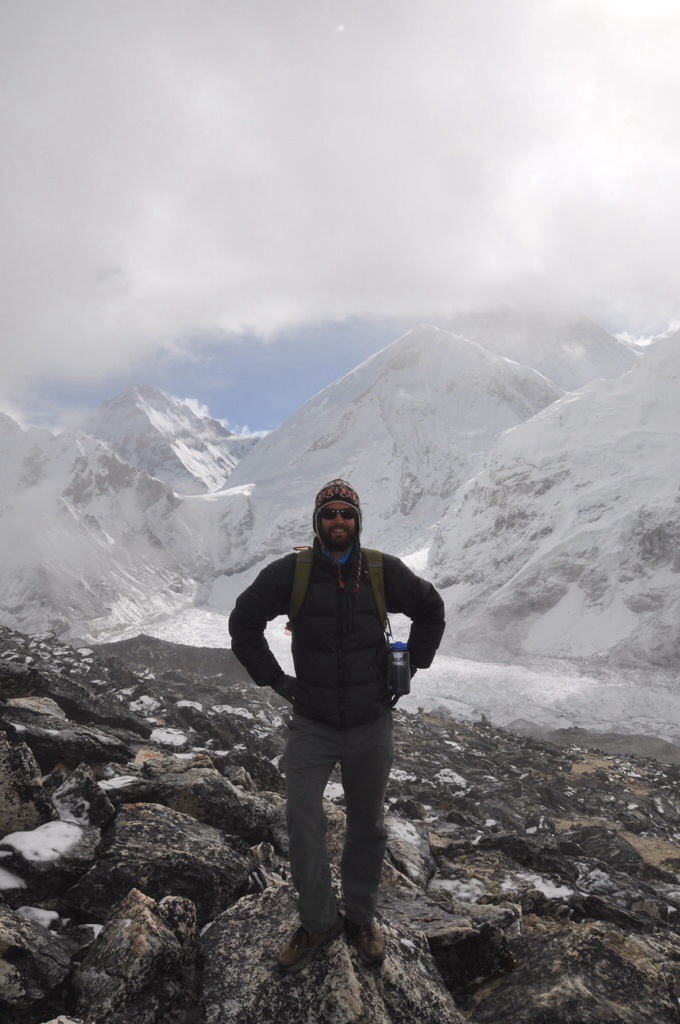
The best view we got. That tall mountain on the right, its top still in the clouds, is Everest. EBC is on the ice flow at the bottom of the picture.
Back to the bottom
After reaching EBC and KP, we headed down as quickly as possible. Given the three days we’d lost at the beginning of the trek, we were already a little behind and so every day we could make up would be helpful. Although we were hiking for twice as long, it felt easier, as with each drop in altitude every step became easier. Breathing was easier. We could focus more on the scenery without needing to think about our steps. And we could have a beer or two!
After two days we made it to Lukla and our weather luck had changed – we were on the first plane out and there wasn’t any weather to stop us. No helicopter necessary!
While tough and taking two weeks, it was an amazing experience and both Jami and I were glad we had done it. The work required to hike that far only made the views of Everest, the other peaks, and the beautiful valleys just that much more spectacular.





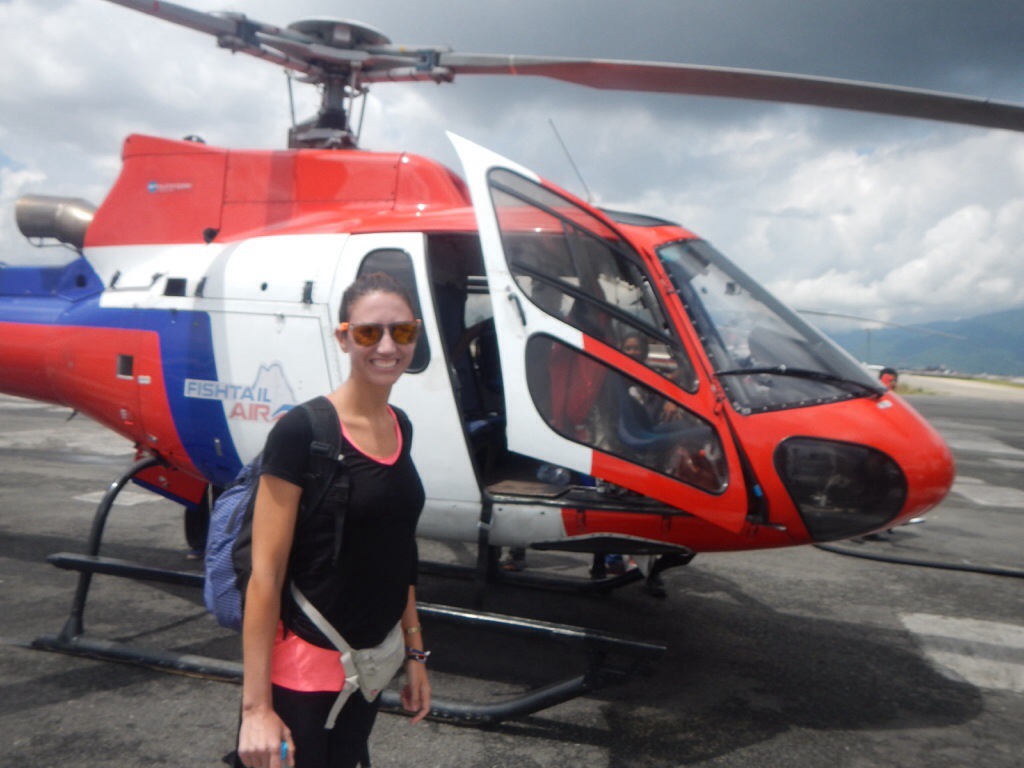
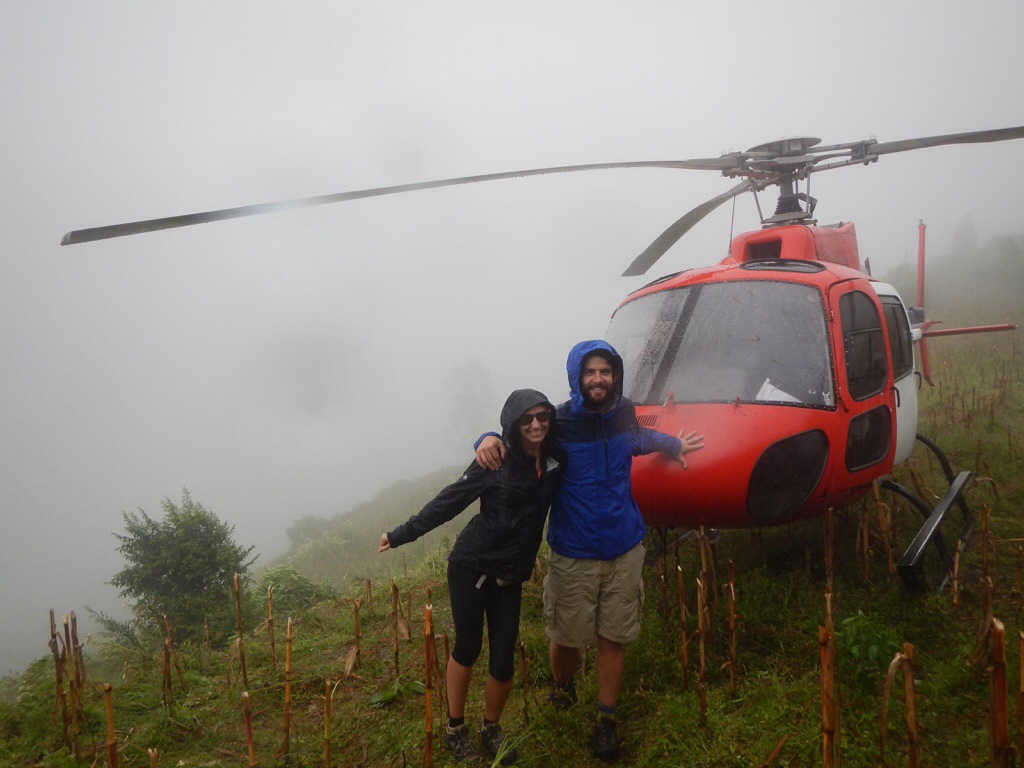
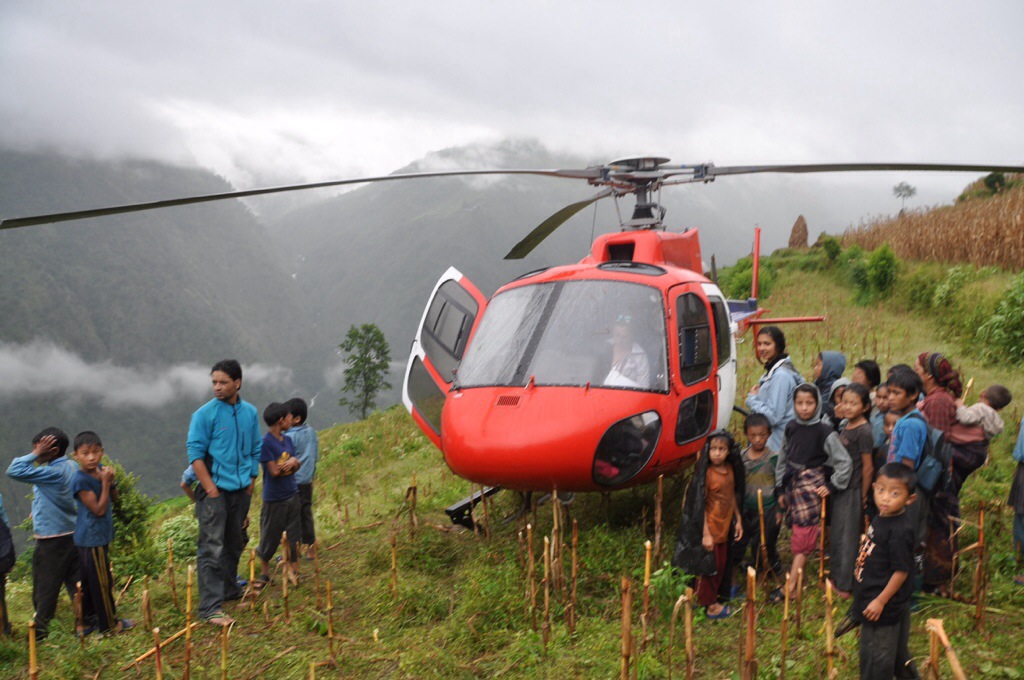
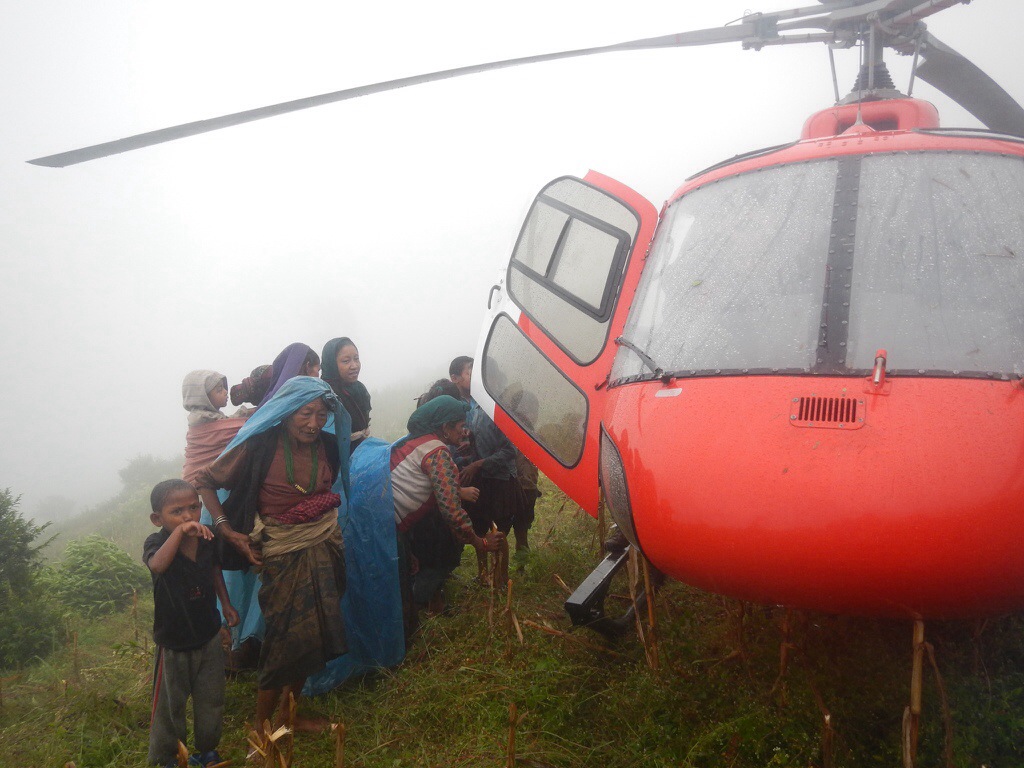
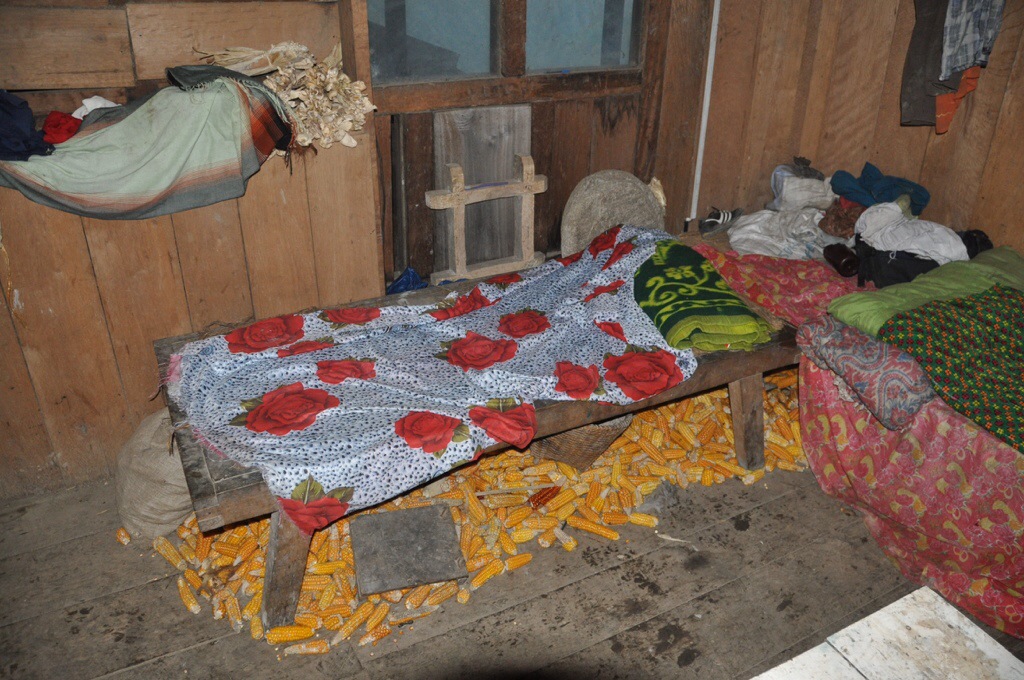
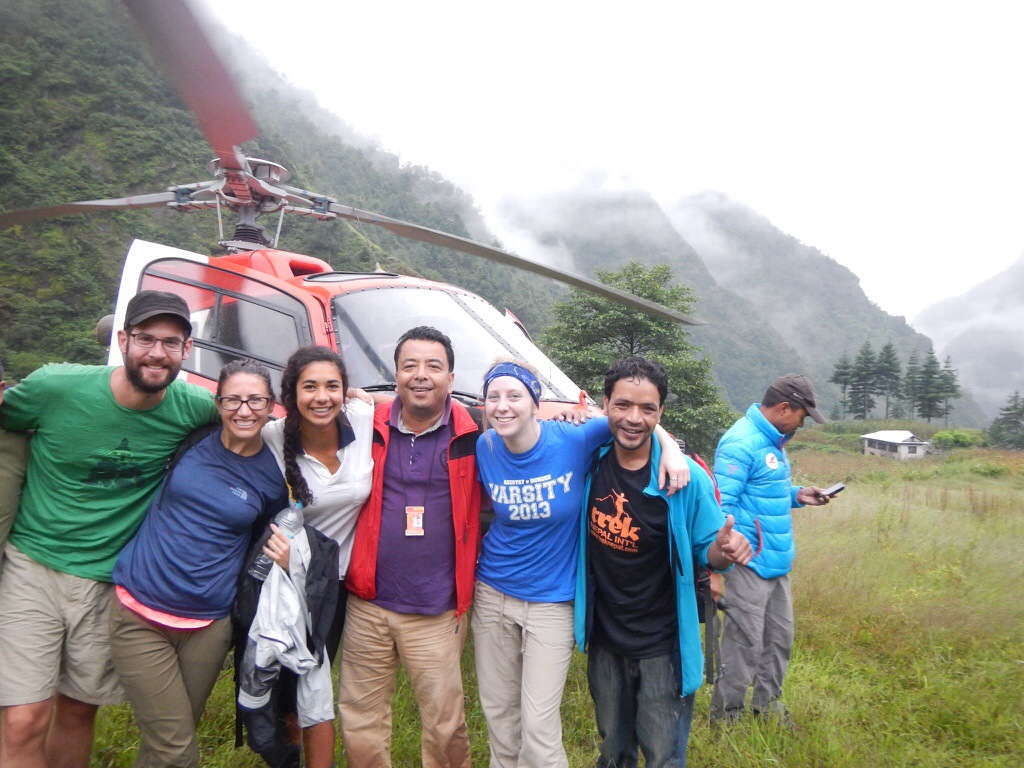
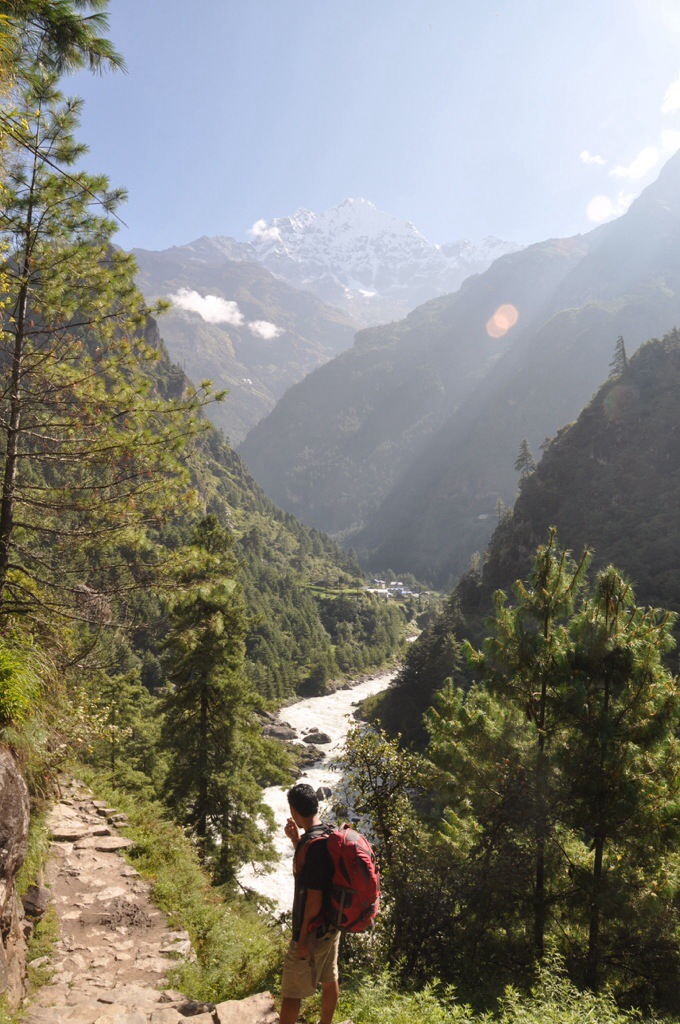
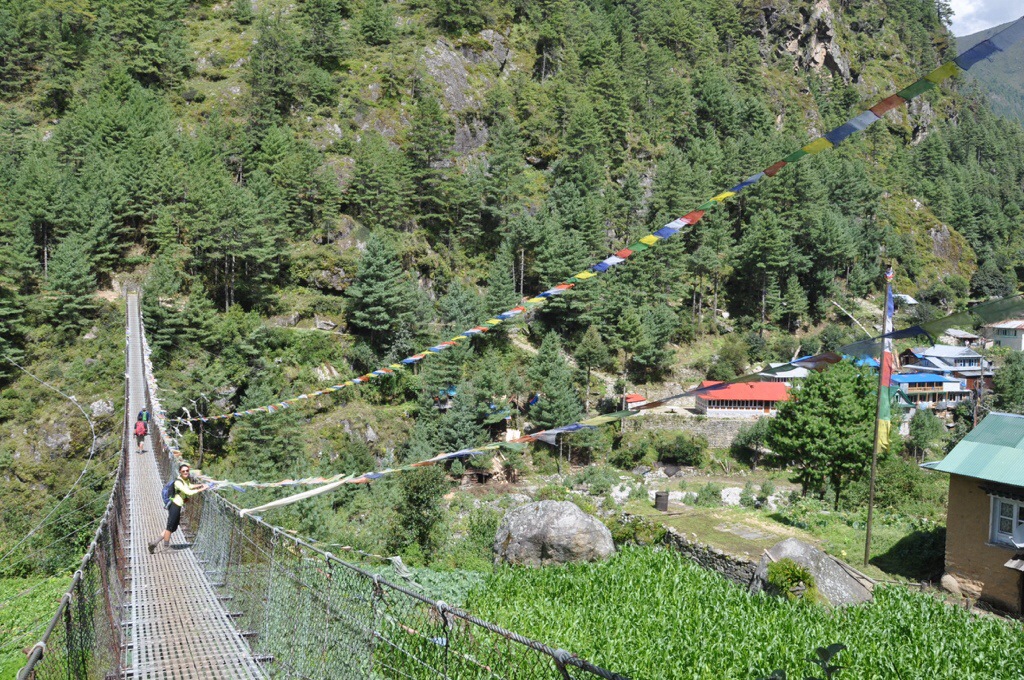
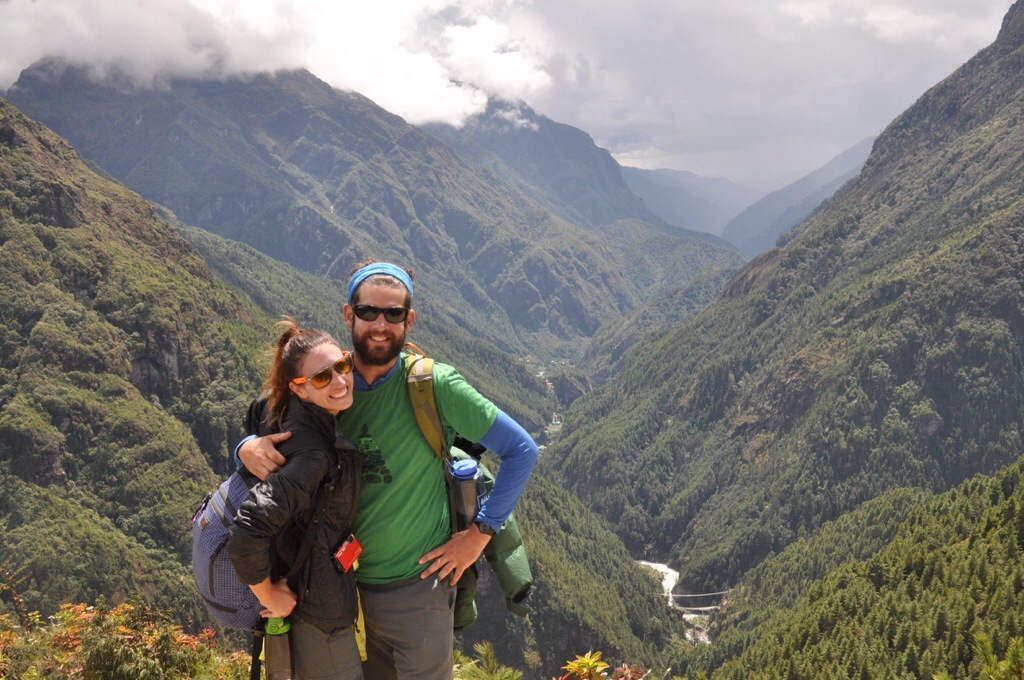
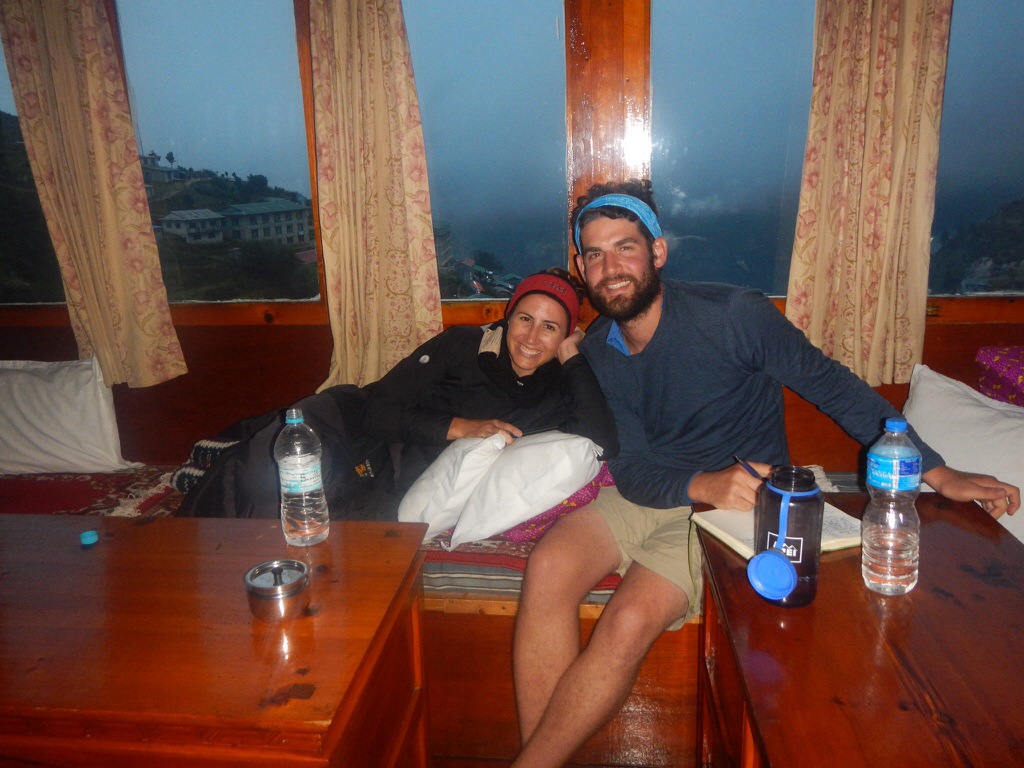
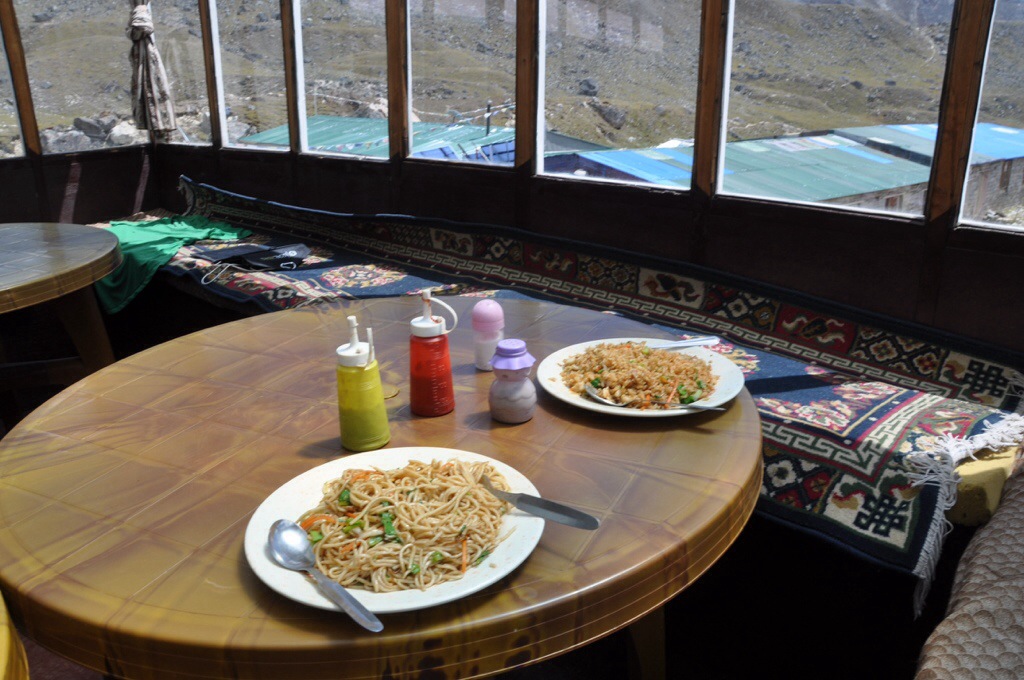
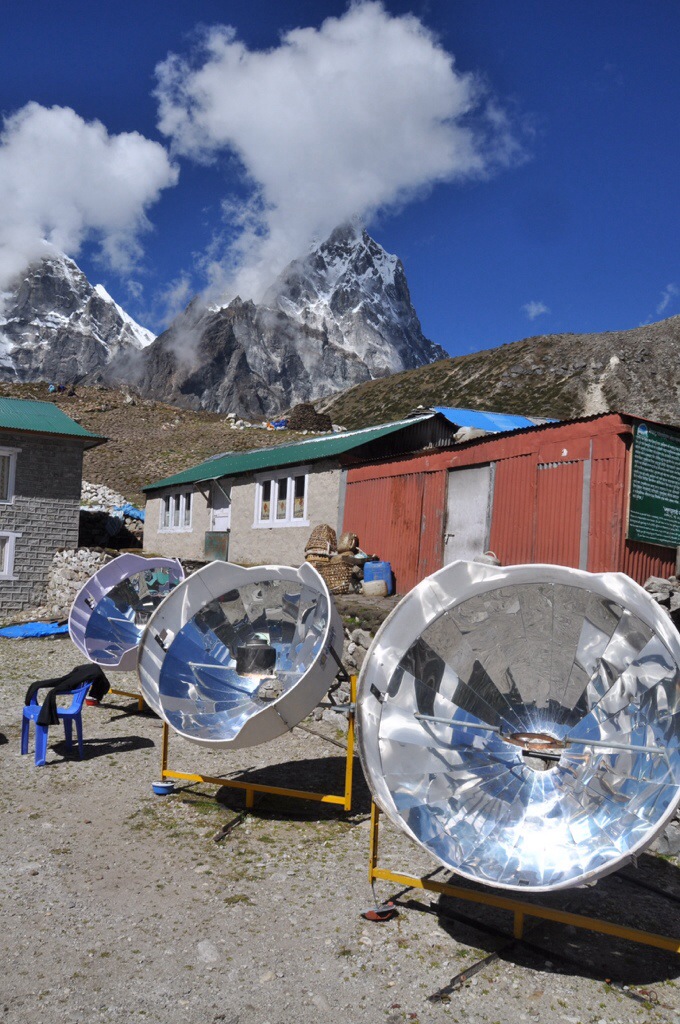
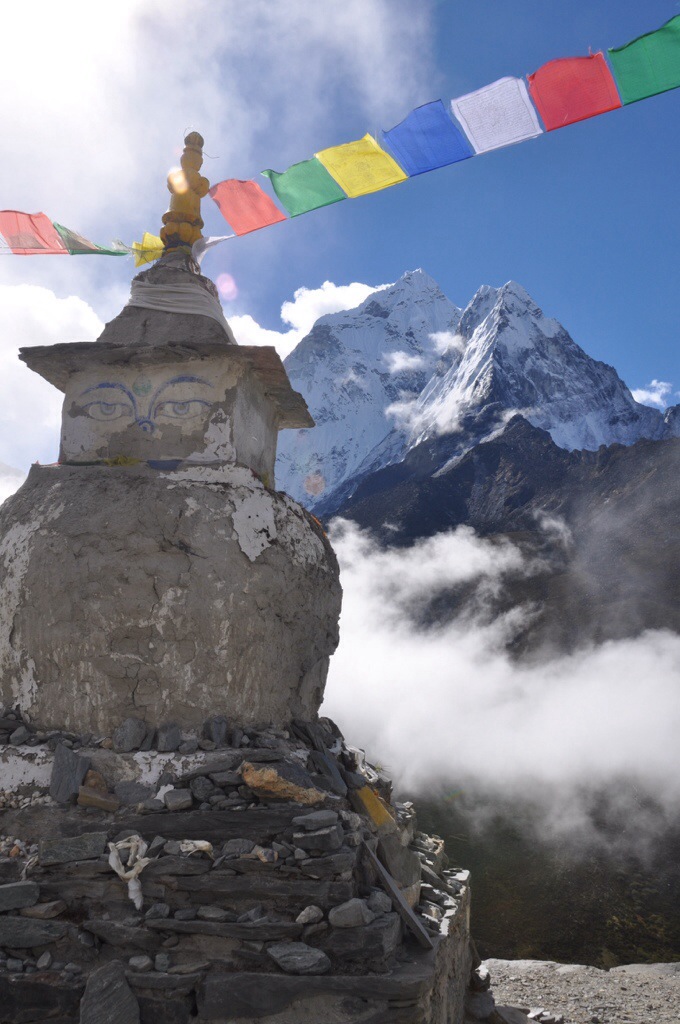
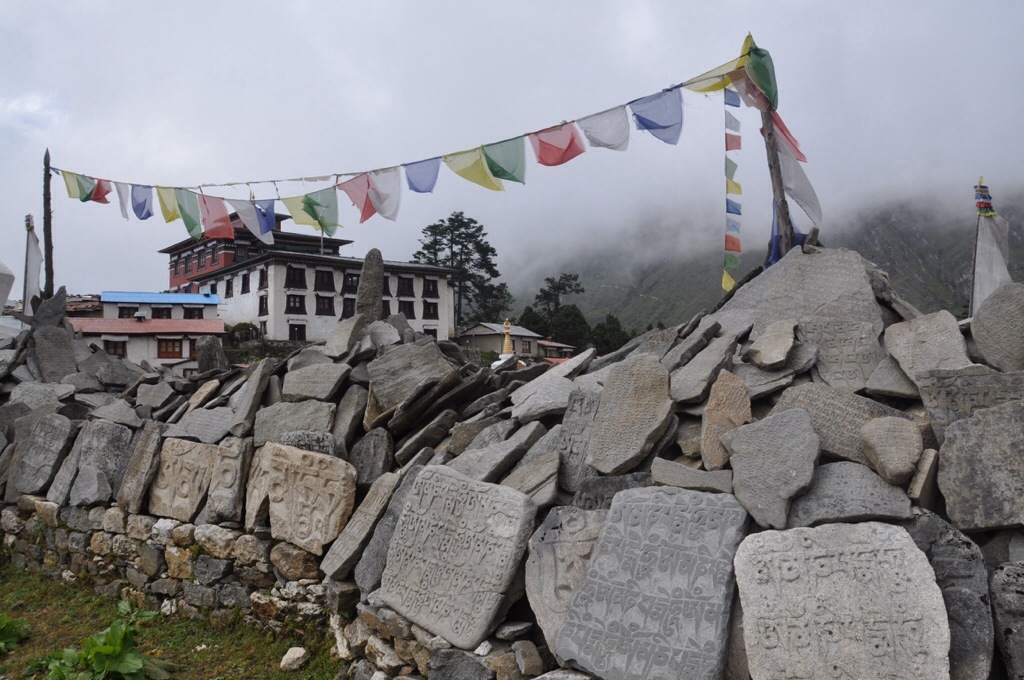
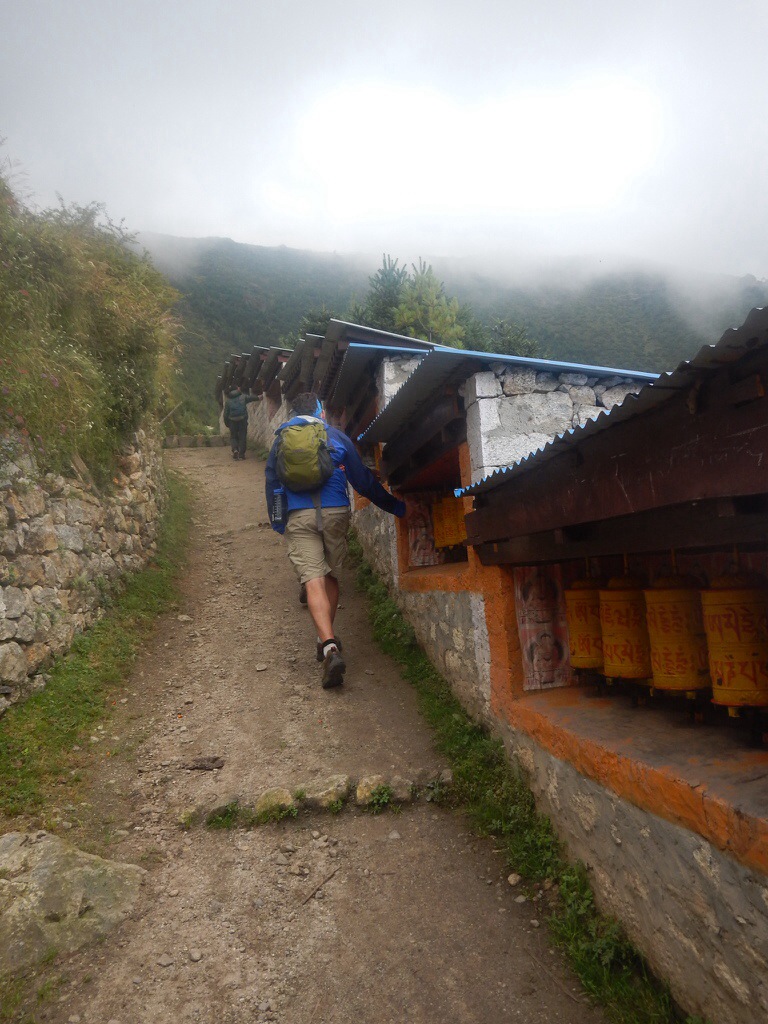
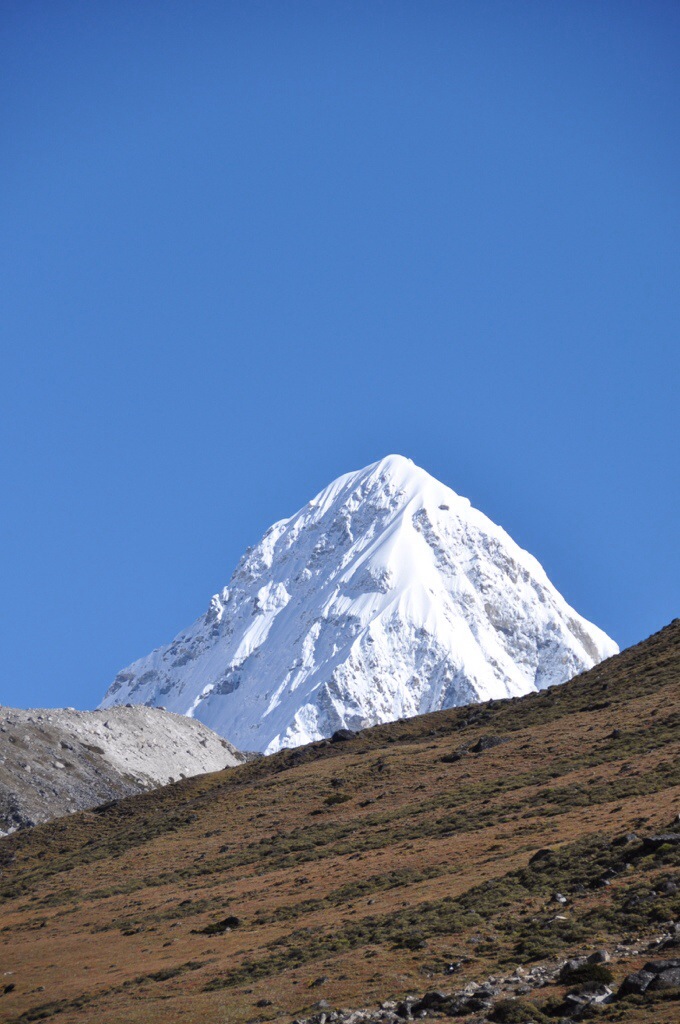
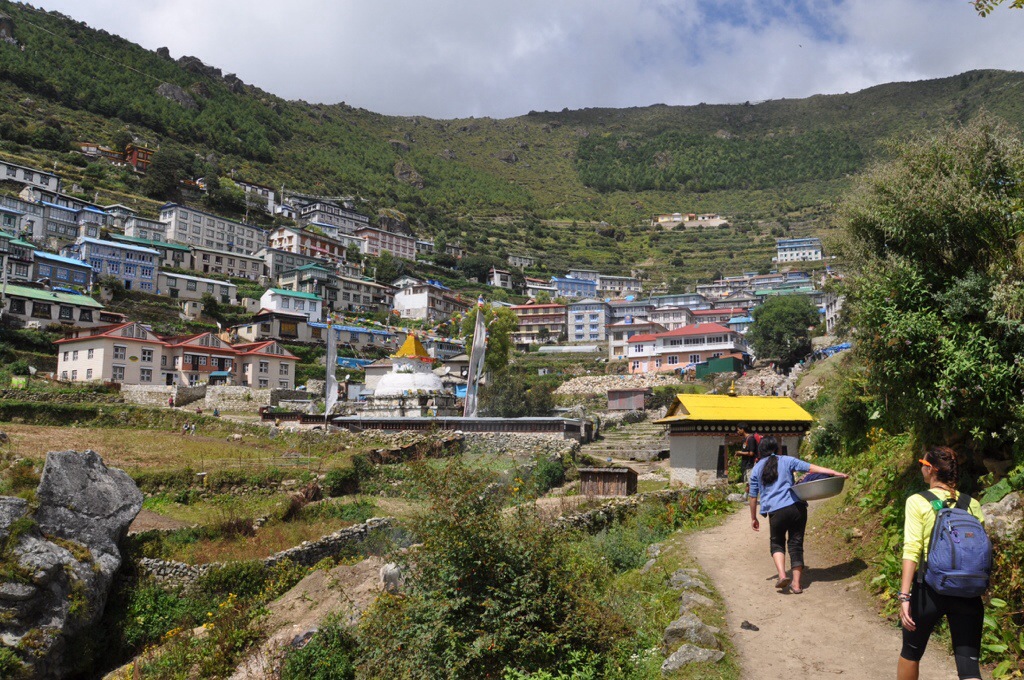
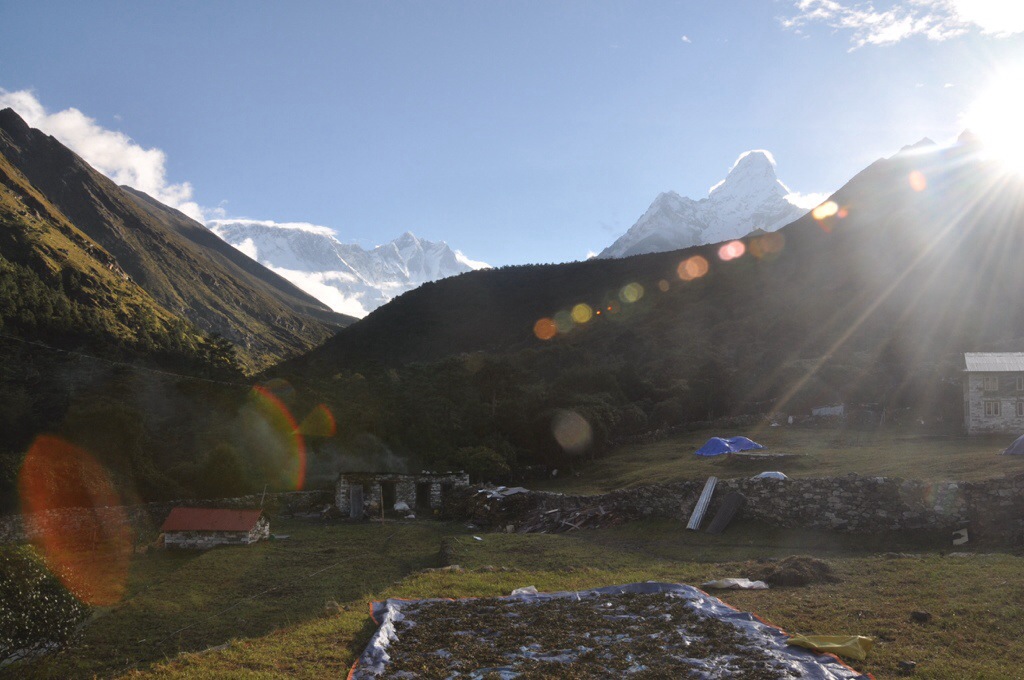

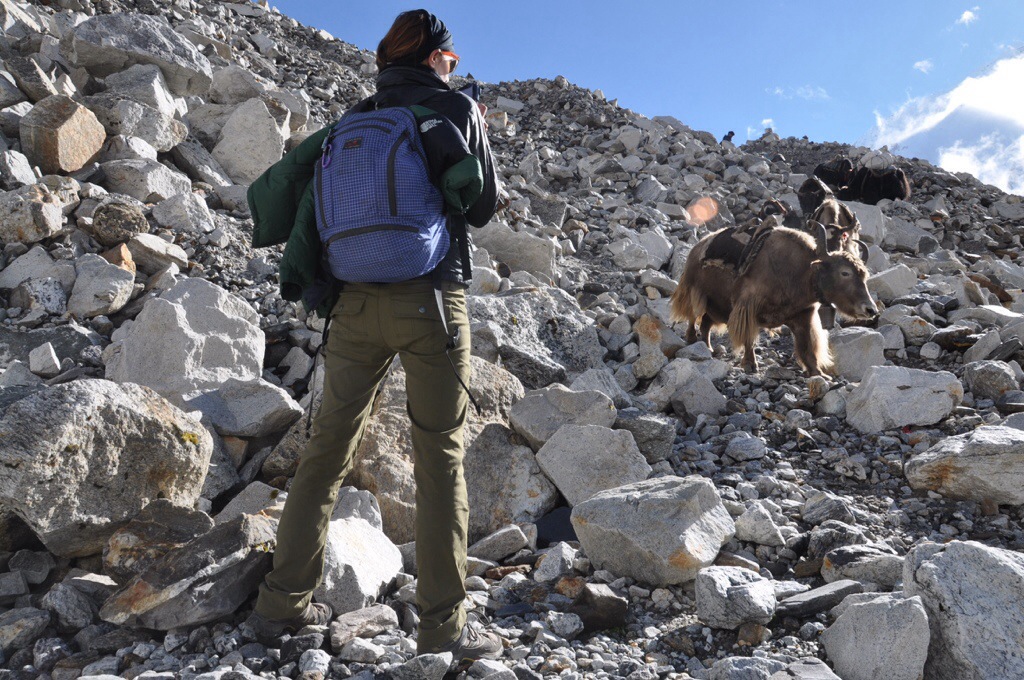
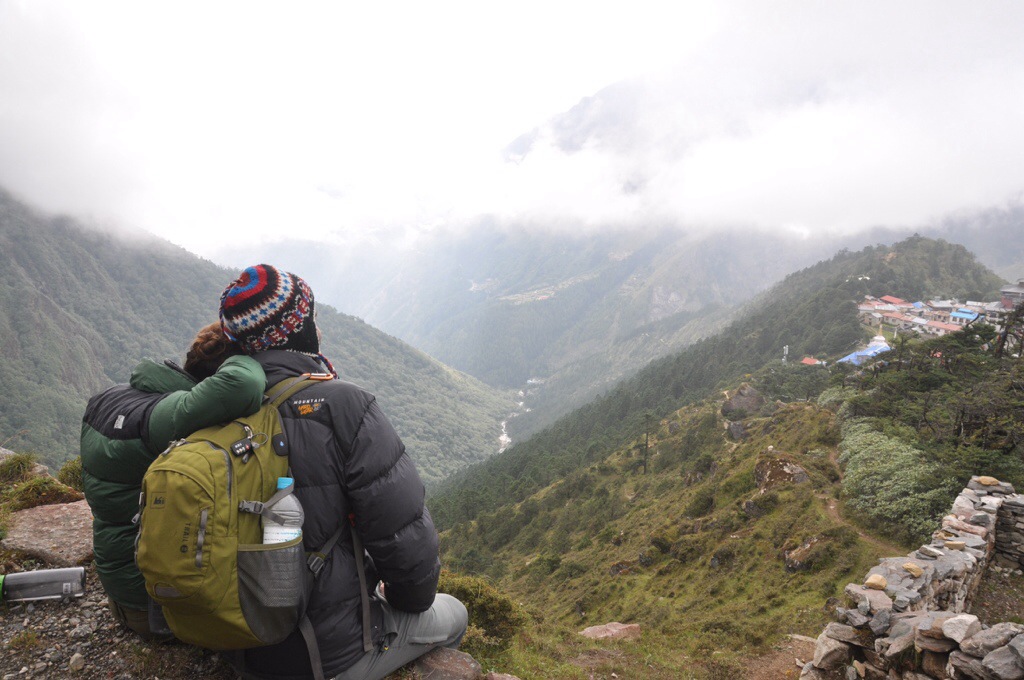
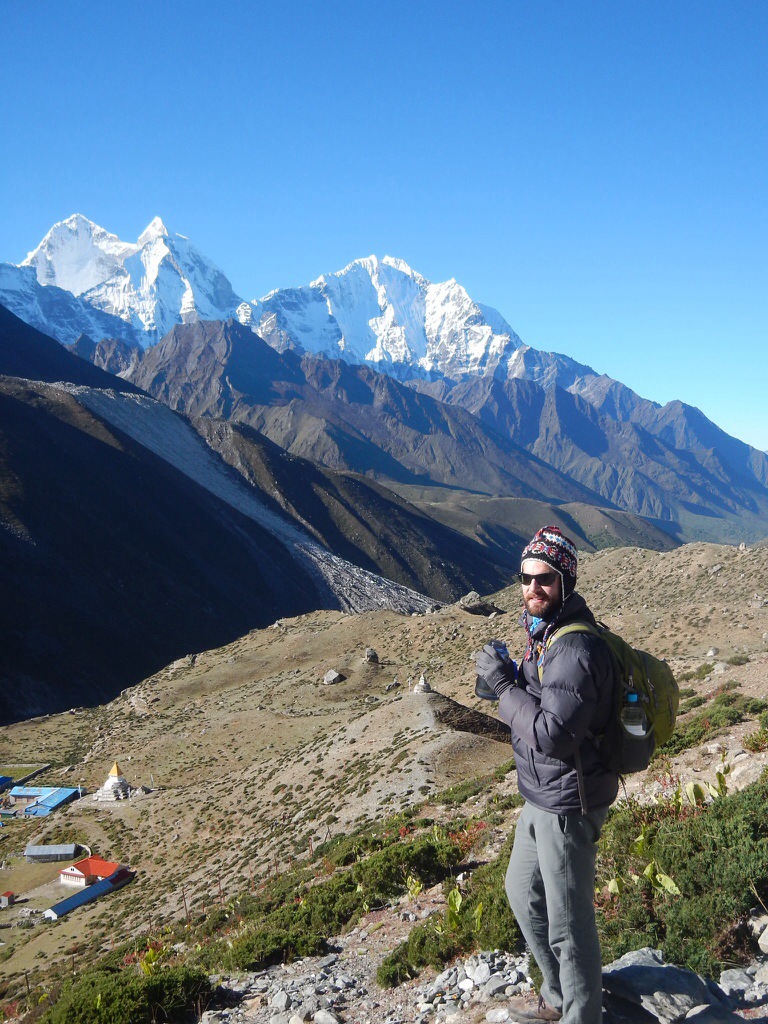
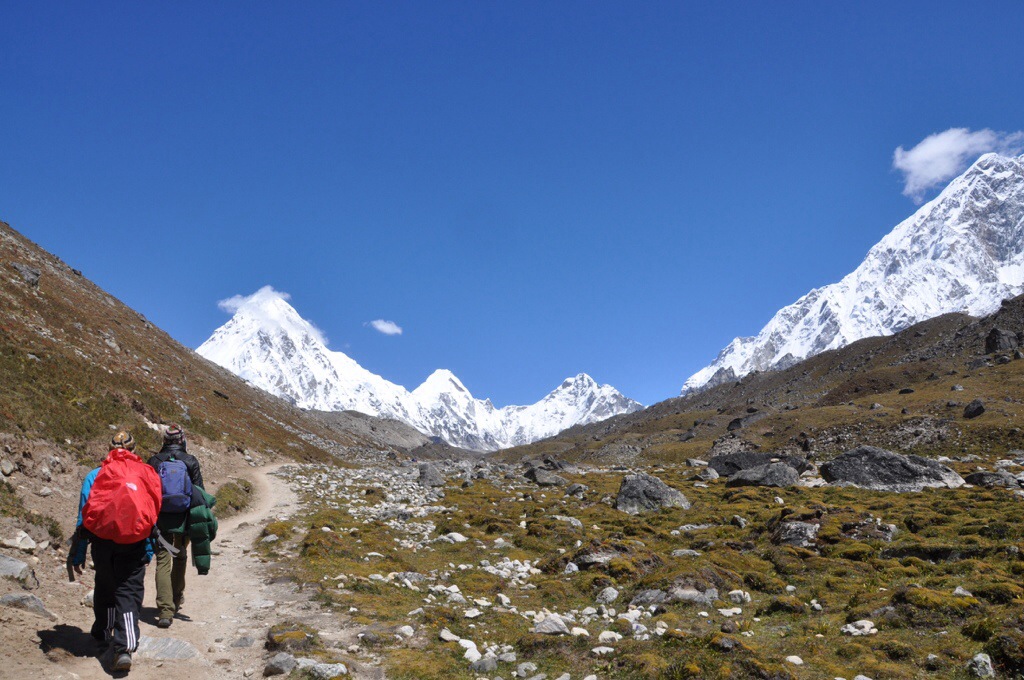
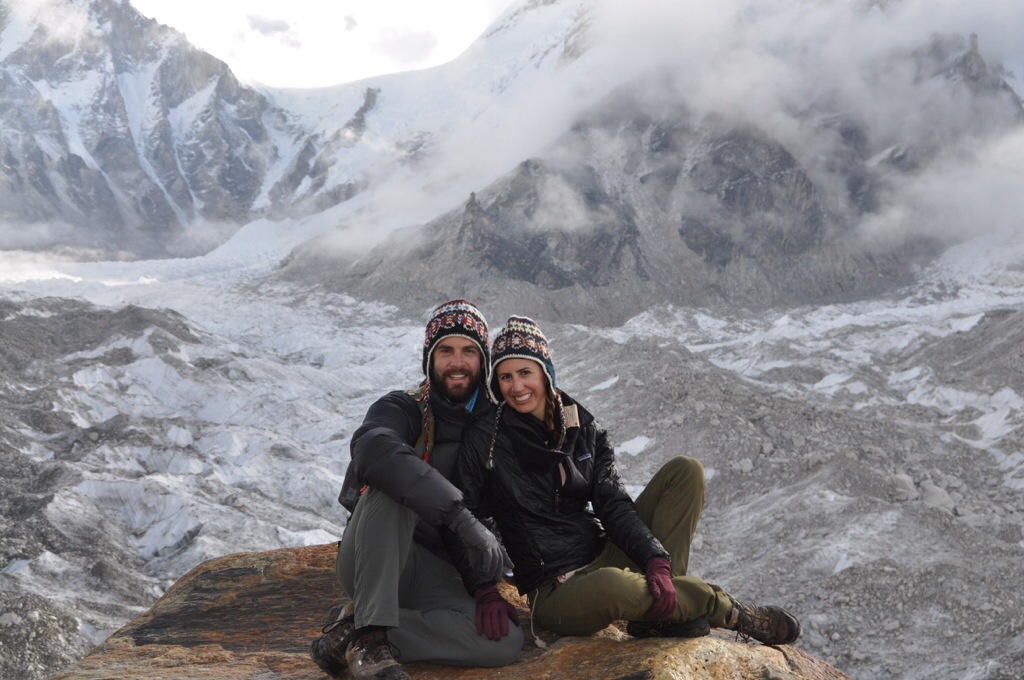
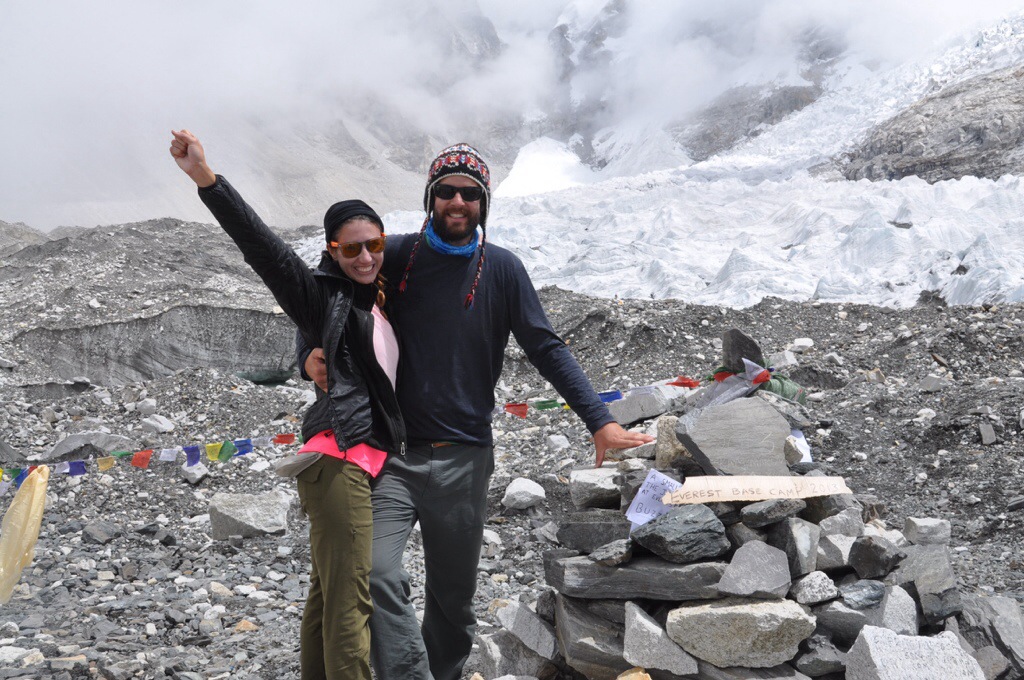
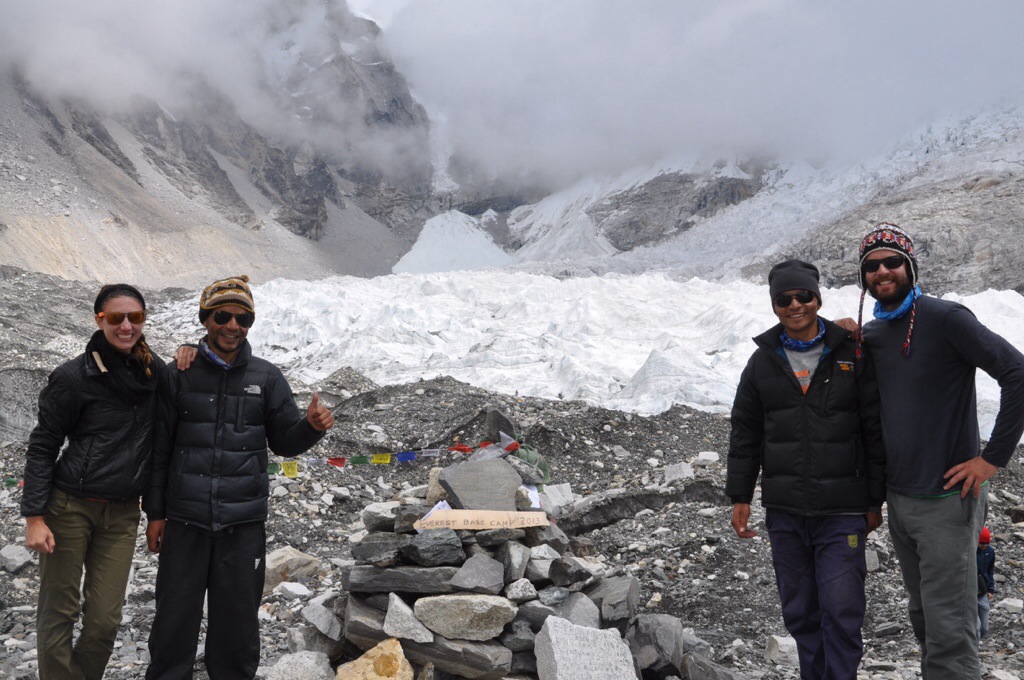
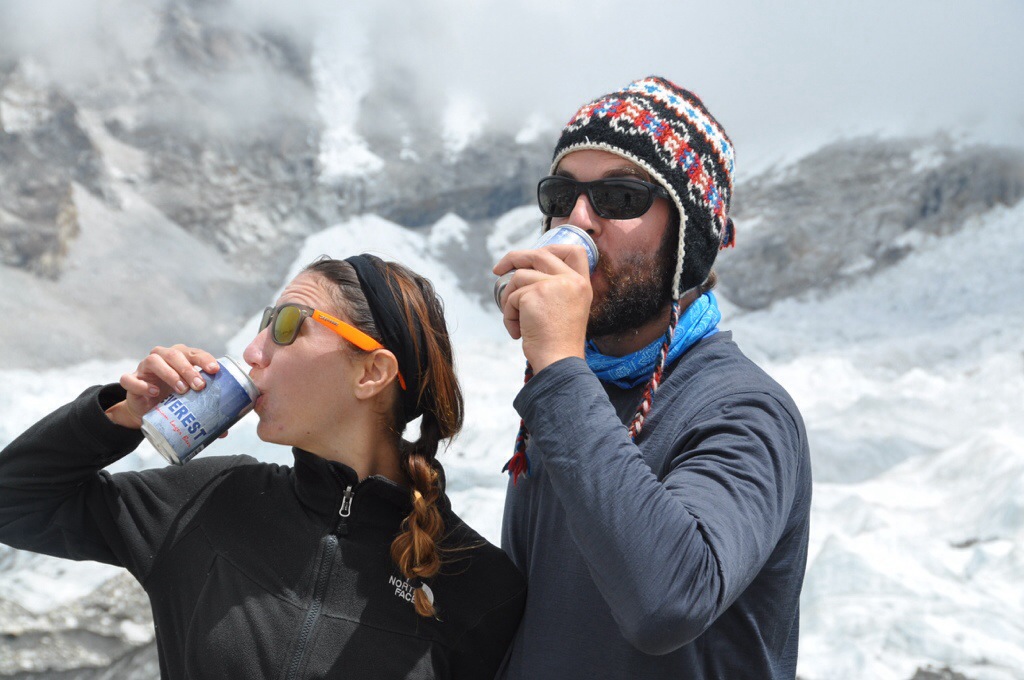
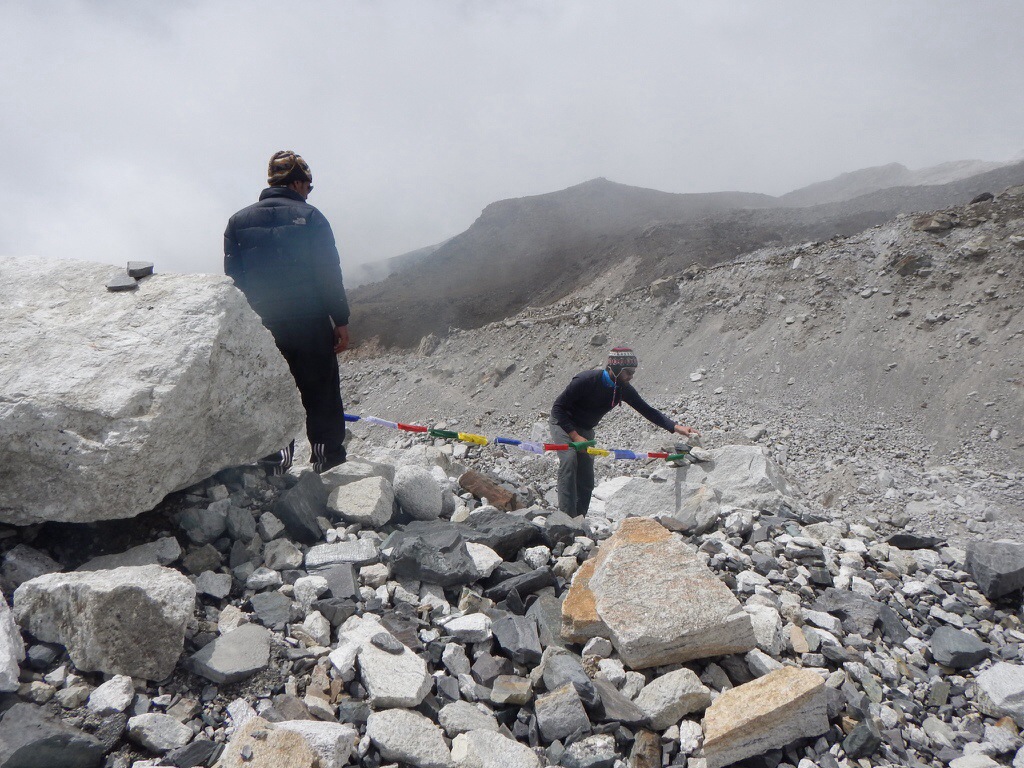
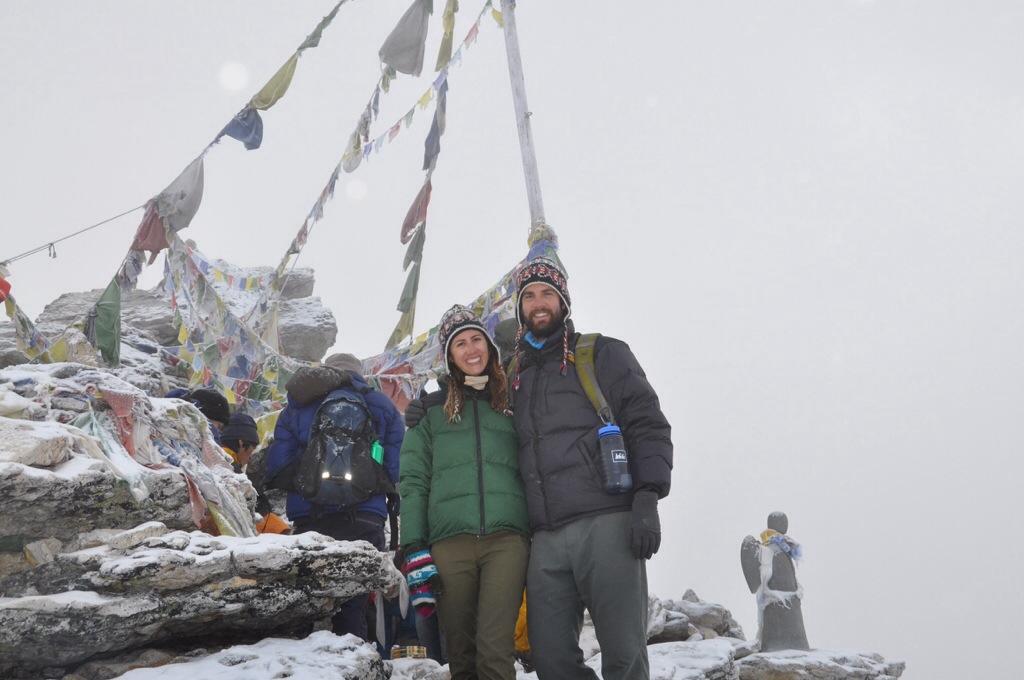
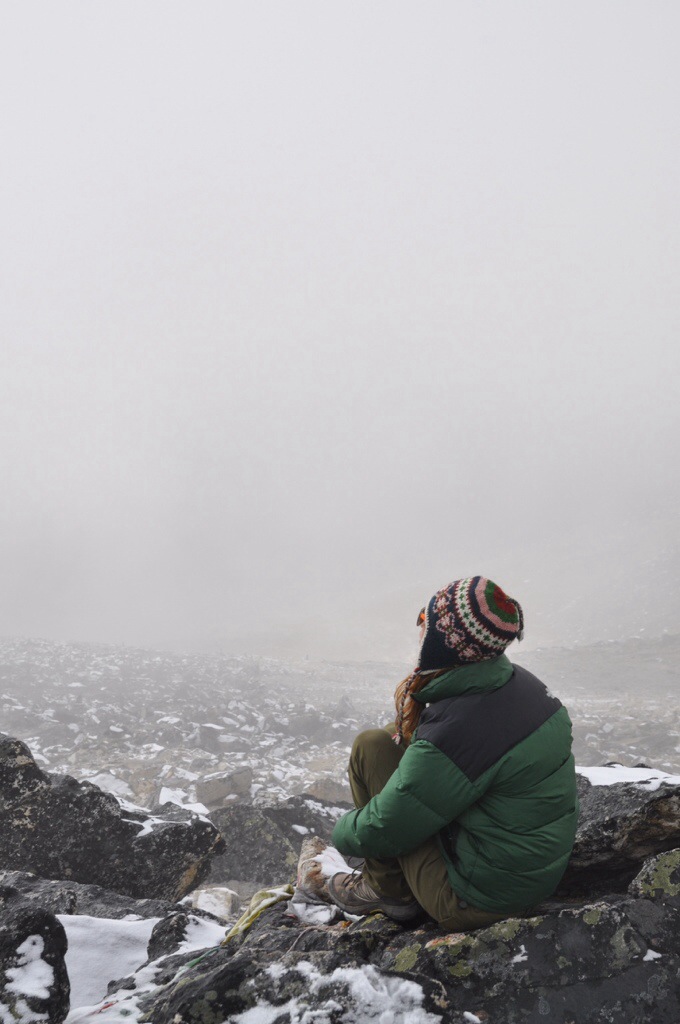
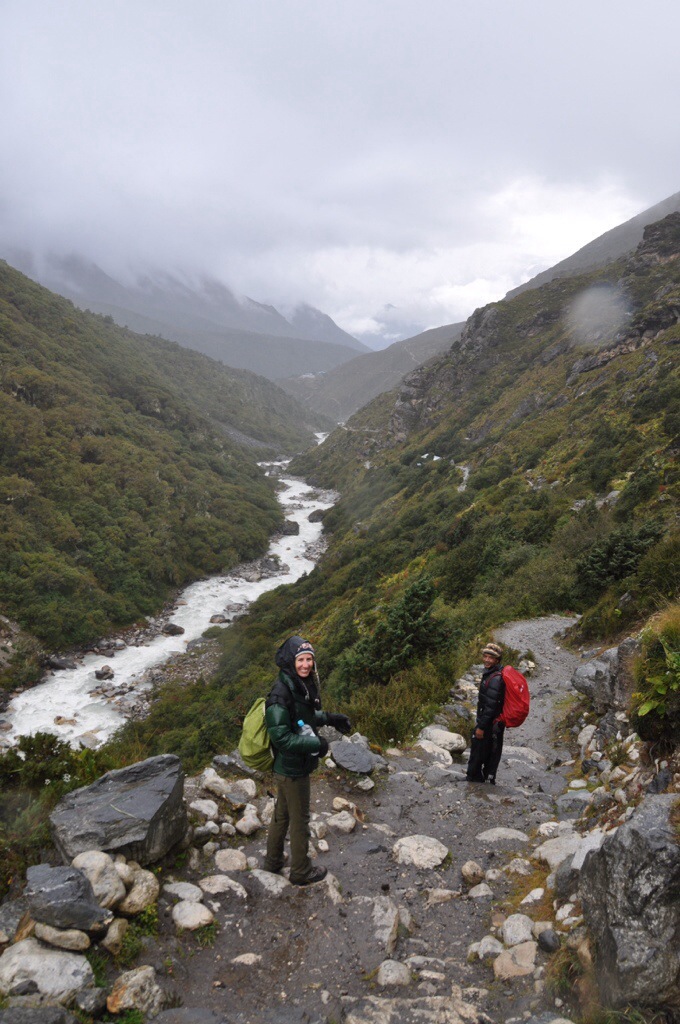
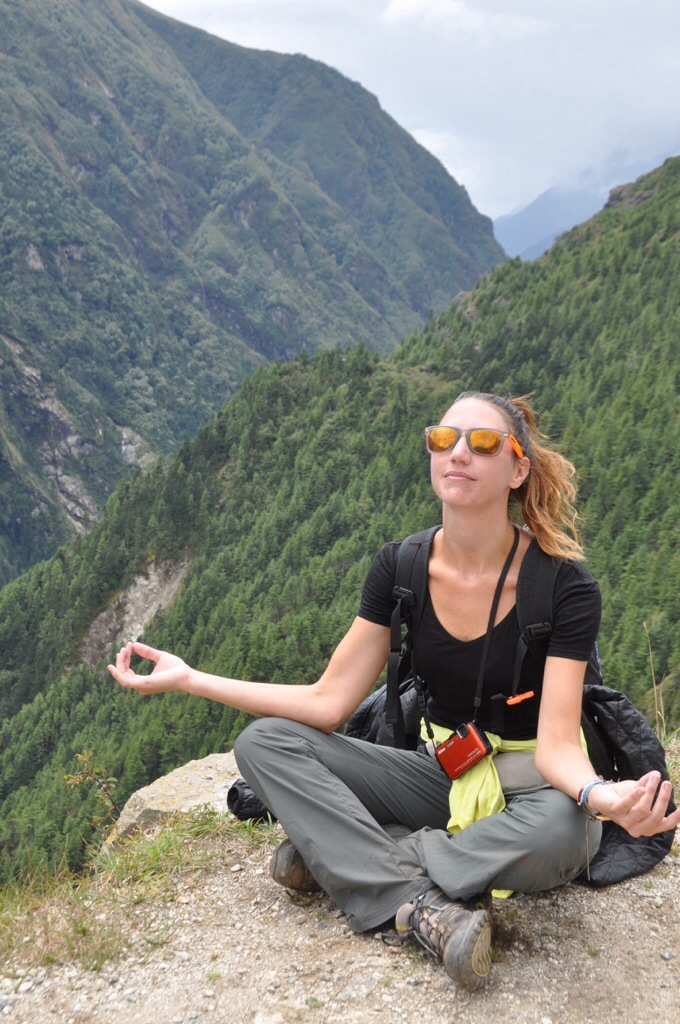
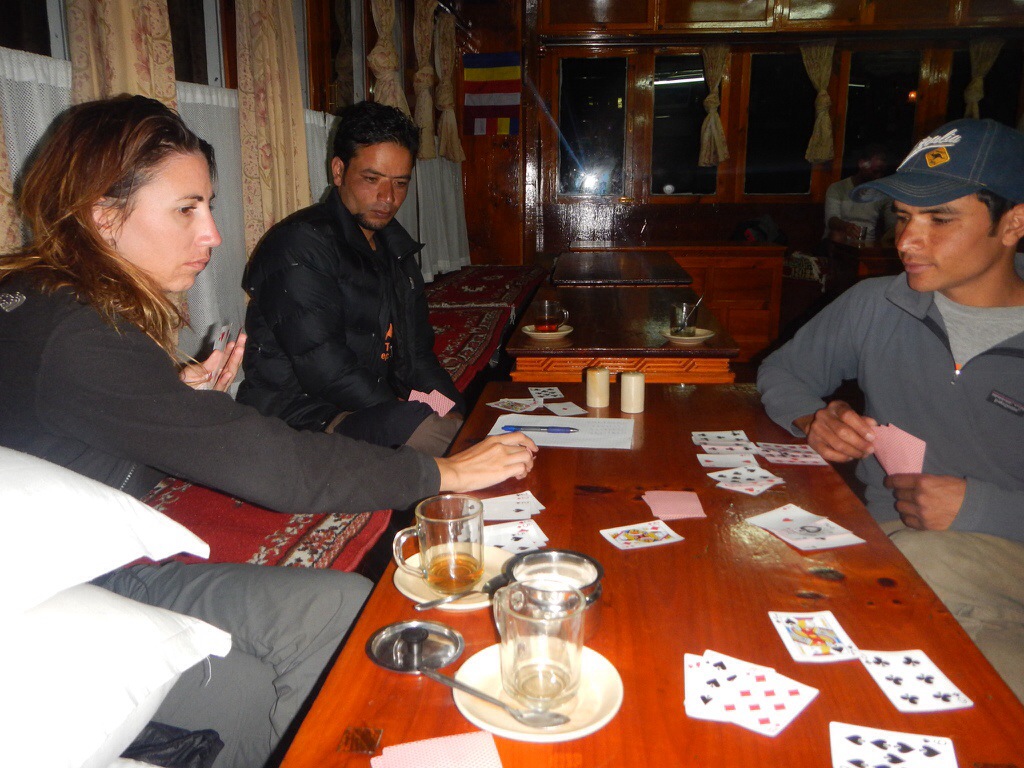
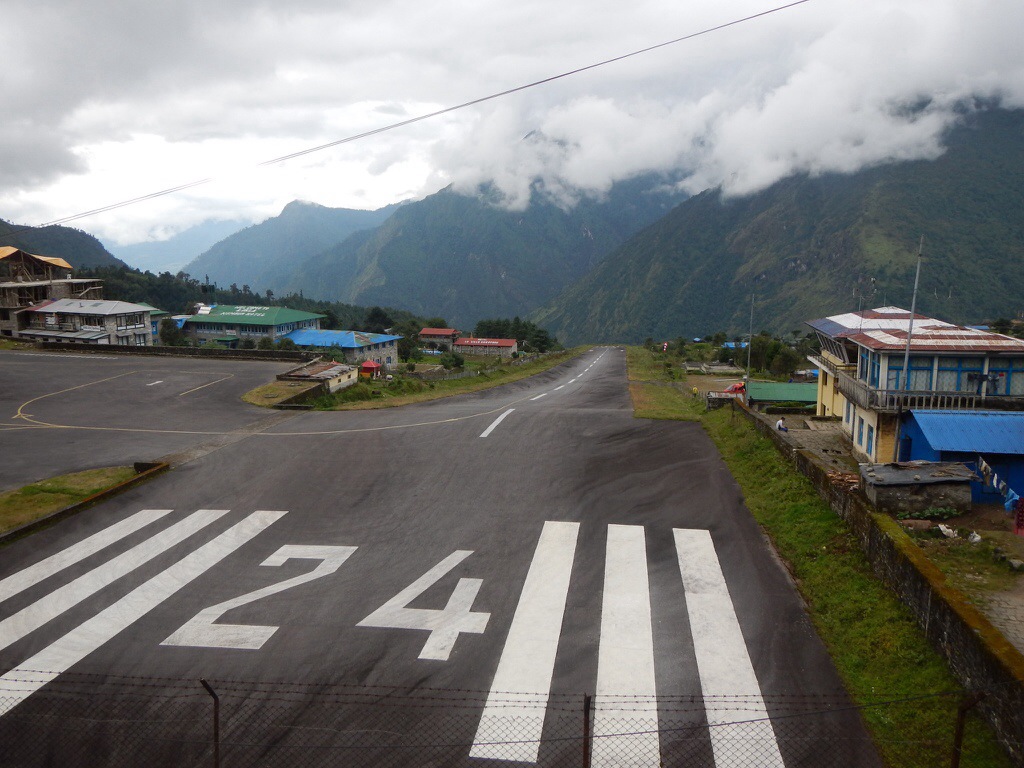
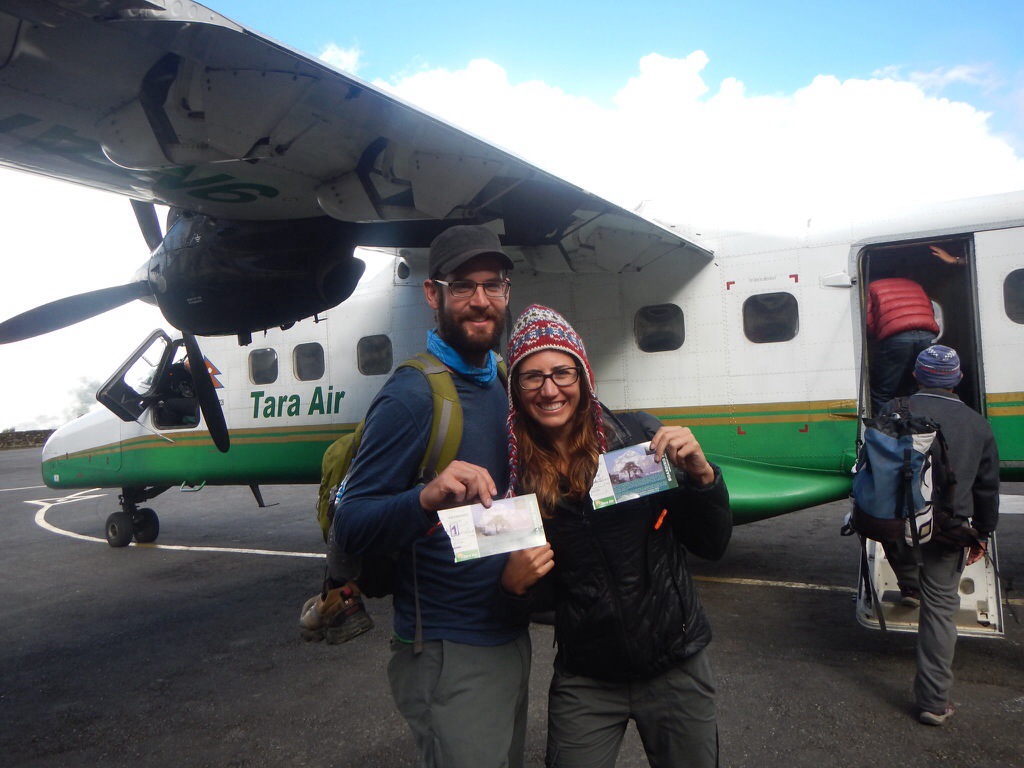
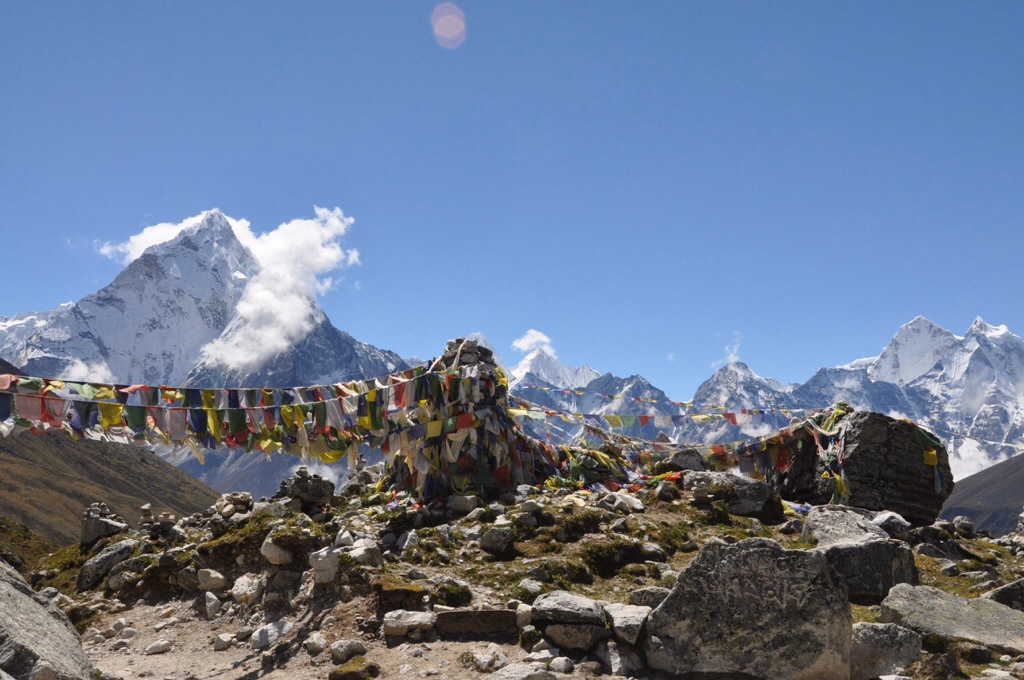
Spectacular! The bridges looks like amazing feats of engineering.
You and Jami are two tough hikers.
What a great experience! The weather and helicopter adventure added some suspense to an already amazing adventure. Great job on the narration and the photos! It really felt like I was there. I kept vacillating between wanting to do it (great mountain views, hiking through the villages, following the footsteps of the Everest mountaineers) and then not wanting to do it (funky toilets, bucket showers and no heat). I have two questions…..Jami, did you color your hair? Are you guys diligently using your sunscreen?
Answers:
1) I had done what is called an ombre dye job back in April, before we took off on leg one. Ombre is when the top is dark and the bottom is light. Because my hair is always up, you don’t notice it. I also got a hack hair cut in Africa, so it’s much shorter. 2) SPF always. In fact, if you look closely our faces are much lighter than our bodies. PS – packing post is coming 🙂
Loved it! How can I get more of your blogs? I was at base camp on the Tibet side about 10 years ago…it is reachable by jeep!
Jill, glad you liked it! We heard great things about the Tibetan side but didn’t have time to go over the border.
You can find the rest of our blog entries a few ways – you can click on the list of countries or dates on the right hand sidebar to view by country or date; or you can click on the “Journey” link at the top and zoom in on the map to see posts from different locations. Clicking on the map markers will bring up the posts from that city.
I am so impressed by your adventurous spirits. The photos and narrative are amazing. Thank you for posting this–I will probably never get there and appreciate the opportunity to enjoy this much with both of you!
Aaron, your description (& photos) of the trek was great, really gave me a good sense of the trip. Now a few questions…
Your cold weather gear (down jackets, gloves, etc)… did you just rent that for the 2 week trek? What did you use for shoes/boots?
Did Jami achieve her goals: stay warm, stay dry, & no blisters?
Leeches played a big role in the several descriptions I’ve read about the approach to Everest… but they did not show up here. What’s up?
There are an infinite number of trekking supply stores in the tourist areas of Kathmandu, carrying every fake North Face item you could want (probably a few real ones too, but you have to know the stores.) we were only able to rent the sleeping bag and down jackets; we had most of the other things we needed but bought a few cheap additions (some of which we just sold back to stores after the trek.) For shoes we just used the hiking shoes we’ve had on us all trip, they were more than fine. No leeches at all, but we were at the tail end of the rainy season.
As for Jami, she’ll have a post soon with info on her take.
Amazing, Aaron! Congrats to you and Jami. What a fete!
Thanks!
This is amazing guys!! Each time I look at your blog, my bucket list grows longer. Thanks for sharing your adventures!
Thanks man!
Amazing Everest blog. We are so impressed with what you two are accomplishing, keep it up.